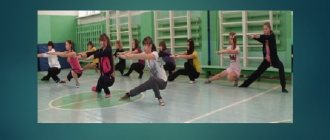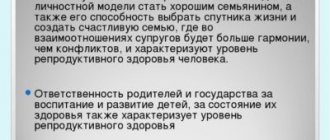Lesson plan 10th grade topic: World population
“General review on the topic “Geography of the world’s population” Lesson objectives
:
- Check students' understanding of key provisions of the topic and knowledge of basic terms.
- Activate the cognitive activity of students, develop interest in the subject.
Form:
lesson-game “Expedition”.
Means of education
: wall maps (political, population density, peoples) and tables on the topic “Geography of the world’s population.” The tables are moved in twos, on them are geographical atlases of the world, working route sheets of groups (Table 1)
Group No.
Table No. 1
| № | Stage surname _ | I Understand me | II Troubles from a barrel | III Identify correspondences _ | IV Hurry up to see | V Dark horse | VI Blitz tournament | VII Translator Competition _ _ | VIII Chance | Bottom line |
| 1 | ||||||||||
| 2 | ||||||||||
| 3 | ||||||||||
| 4 | ||||||||||
| 5 |
Preparing for the lesson
: The class is divided into teams. Participants choose a team name and captain. The captain makes a list of team members, distributes who will answer questions, evaluates students' answers, and keeps order.
The topic of the lesson and a table indicating the commands and task numbers are written on the board, in which, as the lesson progresses, the teacher notes the number of points received. For each task, the number of points with which the task will be assessed and the time allotted for its completion are indicated. The grade for the team response is given by the teacher.
The task of the groups is to safely complete each stage of the expedition, using knowledge and skills, showing friendship, cohesion and mutual assistance.
I round "Understand me".
(Brainstorming. Preparation for dictation on concepts).
1. This is the science of the laws of population reproduction, studying its size, natural increase, age and sex composition, etc. (Greek demography
)
2. The set of processes of fertility, mortality and natural increase, which ensure the continuous renewal and change of human generations. ( Reproduction or natural population movement)
3. This indicator is characterized by relatively low rates of fertility, mortality and natural increase. ( Type I of population reproduction)
4. The phenomenon of rapid population growth in countries of type II population reproduction has received a figurative name in the literature since the mid-twentieth century. ( Population explosion)
5. A system of administrative, economic, propaganda and other measures through which the state influences the natural movement of the population (primarily the birth rate) in the direction it desires. ( Demographic policy)
6. Part of the working population that participates in material production and non-production spheres. ( Economically active population)
7. Historically established, stable community of people. (“ Ethnos” – Greek people)
8. Growth of cities, increasing the share of the urban population in the country, region, and world. ( Urbanization)
9. States in which national borders coincide with political ones. ( Mononational)
2nd round “Troubles from a barrel.”
Teams receive cards with questions. 30 seconds are given for discussion. Representatives from each team then read out the questions and give answers. The answer is assessed on a 5-point system.
1. The ancient Greek mathematician and philosopher Pythagoras, who considered human life in terms of the seasons, proposed to distinguish four seasons in it: spring (childhood), summer (youth), autumn (maturity), winter (old age). Based on what criteria can the population of a country be assigned to a particular time of year?
2. New York has more Irish people than Dublin, more Jews than Tel Aviv, it has its own “Little Italy”, its own “China Town”. How do you explain the modern multinational structure of the United States?
3. Insert the missing phrases into the text:
“The number of men is higher than the number of women in those countries where...”
“The large predominance of men in ... and …” has a particularly strong impact on global attitudes.
4. People in these settlements live very secludedly. Communication with the outside world is carried out mainly through telephone and radio.
— What form of settlement are we talking about?
— In which countries is it common?
Answers:
- These criteria are indicators of fertility, mortality and natural increase.
- The indigenous population of the United States was practically exterminated, and modern residents of the United States are descendants of migrants from different regions of the world.
- The position of women has historically been disadvantaged economically and socially, and in countries with a large influx of men for work.
- The text describes life on a farm. This is a rural dispersed form of settlement. Distributed in Canada, USA, Australia.
III round. Identify matches.
(Work on cards No. 1–4).
№ 1.
| 1. Labor resources | a) Ratio of economically active and non-working population |
| 2. Economically active population | b) The working population of the country |
| 3. Demographic load | c) Population actually involved in material production and non-material sphere |
| 4. Megalopolis | d) Cluster of agglomerations |
№ 2.
| 1. Urbanization | a) Cluster of cities |
| 2. Suburbanization | b) Relocation of part of the wealthy population to the suburbs |
| 3. Slum urbanization | c) The growth of cities leads to the formation of poor neighborhoods with unsanitary living conditions |
| 4. Agglomeration | d) Growth of cities and urban populations, spread of urban lifestyle |
№ 3.
| 1. Agglomeration | a) The historical process of the emergence, growth of population and number of cities, concentration of economic potential in them |
| 2. Megalopolis | b) “Flight” of the population from big cities to the suburbs associated with the decentralization of industry |
| 3. Urbanization | c) A cluster of nearby settlements, often forming an area of almost continuous urban development |
| 4. Counter-urbanization | d) Group of agglomerations of settlements |
№ 4.
| 1. Ethnicity | a) The phenomenon of rapid population growth in countries of type II population reproduction since the mid-twentieth century |
| 2. Urbanization | b) Historically established, stable community of people |
| 3. Population explosion | c) Growth of cities, increasing the share of the urban population in the country, region, world |
| 4. Agglomeration | d) Cluster of cities |
Answers:
No. 1 – 1b, 2c, 3a, 4d.
No. 2 – 1d, 2b, 3c, 4a.
No. 3 – 1c, 2d, 3a, 4b.
No. 4 – 1b, 2c, 3a, 4d.
IV round. Hurry up to see.
Teams determine the type of population reproduction according to the age-sex pyramid. Explain the choice. 5 points.
Determine which age-sex pyramid is typical for countries with type I of population reproduction, and which for countries with type II of population reproduction. Justify your answer.
Explanation: the type of reproduction of a country's population can be determined by the proportion of young and old ages. The pyramids, characteristic of type I reproduction, have a wide base, which indicates a large proportion of young people in the country’s population; the proportion of elderly people is extremely small. The narrow base of the pyramids, characteristic of type II reproduction, indicates a reduced proportion of young ages. The proportion of elderly people is high.
V round A dark horse.
Teams take turns taking concept cards and defining them. For the correct answer - 1 point.
- unitary state;
- the colony;
- constitutional monarchy;
- political and geographical location;
- sovereign state;
- republic;
- absolute monarchy;
- federal state, etc.
VI round. Blitz tournament (strong link).
Each group is asked to answer questions without preparation. For each correct answer the group receives 1 point. (Table 2)
table 2
| № | Question | Answer |
| 1 | What type of population reproduction is typical for Algeria | I |
| 2 | Which of the following peoples belong to the Indo-European language system? Armenians, Jews, Spaniards. | Armenians Spaniards |
| 3 | Which country has the highest birth rate? Saudi Arabia or Spain. | Saudi Arabia |
| 4 | Is the statement true: “A population explosion is an increase in population in developing countries” | No |
| 5 | In which country the motto of demographic policy is: “There are two of us and two of us” | India |
| 6 | Which of the following religions are world religions? Islam, Shintoism, Buddhism. | Islam Buddhism |
| 7 | Which of the following countries are highly urbanized? Kuwait, Afghanistan, Brazil | Kuwait Brazil |
| 8 | What was the reason for the “white emigration” in Russia? | Political |
| 9 | For Russia, who is a person who goes abroad for permanent residence? | An emigrant |
| 10 | Which country has the greatest natural population growth? Canada, Iraq | Iraq |
| 11 | Is the statement true: “The first type of reproduction is characterized by high birth rates and high deaths”? | No |
| 12 | In which country the motto of demographic policy is: “One family – one child”? | China |
| 13 | Which country is one-national? Canada, Denmark | Denmark |
| 14 | Which country is the most multinational? | India |
| 15 | Which of the following peoples belong to the Sino-Tibetan language family? Burmese, Turks, Itzu | Burmese Izu |
| 16 | Which of the following religions are national? Confucianism, Judaism, Christianity | Confucianism Judaism |
| 17 | What megalopolis is located on the Atlantic coast of the United States? | Boswash |
| 18 | Southern neighbor of the USA. | Mexico |
| 19 | Every fourth earthquake occurs in this country. | Japan |
| 20 | Form of government in Japan. | A constitutional monarchy |
| 21 | Prime Minister of Japan. | R. Hashimoto |
| 22 | Southwestern neighbor of France. | Spain |
| 23 | US form of government. | Republic |
| 24 | President of France | J. Chirac |
| 25 | Form of government in Italy. | Republic |
| 26 | Head of the German government. | Schroeder G. |
| 27 | Queen of Great Britain. | Elizabeth II |
| 28 | State on the territory of Italy. | Vatican |
| 29 | Prime Minister of England. | Tony Blair |
| 30 | President of the U.S.A. | George Bush |
| 31 | In which country is the name of the first president named: a city, a mountain, an island (on Lake Michigan), a state? | USA Washington |
| 32 | Indigenous people of Australia? | Aborigines |
| 33 | The most sparsely populated country in the world, where there are no surnames, it ranks first in Europe in ice cream consumption, has the largest number of writers per capita | Iceland |
| 34 | Where do the Indians live? What about the Indians? | In America In India |
| 35 | Representatives of what race inhabit North Africa? | Caucasoid |
| 36 | Why do blacks have curly hair, a wide nose and dark skin color? | Adaptation to hot climates |
| 37 | The most popular type of “urban transport” in Vietnam and China | Bicycle |
| 38 | Are there any countries on Earth where there is not a single villager, i.e. Is the level of urbanization there 100%? | These are microstates whose territory includes one city, for example, San Marino |
| 39 | Name the largest state in South America | Brazil |
| 40 | Which country does the Hawaiian Islands belong to? | USA |
| 41 | Which state occupies an entire continent? | Australia |
| 42 | What animal is depicted on the Australian coat of arms? | Kangaroo |
| 43 | Most widespread language family | Indo-European |
| 44 | What type of migration is referred to as “brain drain”, “brain drain”, “muscle drain”? | External |
| 45 | What did N.N. call? Baransky “command staff of the country’s territory” | Cities |
| 46 | The first city was a millionaire during the time of Julius Caesar. | Rome |
| 47 | How many population censuses have there been in the world since the beginning of the 19th century? | 2 thousand |
| 48 | How often are censuses conducted? | Once every 5 or 10 years |
| 49 | Which group of countries will determine the demographic situation throughout the world? | Developing |
| 50 | What is the average population density on earth? | 40 people/km2 |
VII round. Translation competition.
Team members are offered 2 foreign words. Within 1 minute, determine from which country’s language this word was borrowed in Russian and what its meaning is.
- 1 point is awarded to the team for determining the homeland of the word;
- 2 points for explaining its meaning.
Alliance
– fr. “union of associations”. Union, an association of persons or states to achieve common goals.
Virtuoso
– it. "valor". A musician-performer who has perfectly mastered the technique of performance.
Dismantling
– fr. “disassembly”. Dismantling a machine or structure in order to stop their actions.
Image
– English "Lifestyle". A certain image of a person or thing created by the media, literature or the person himself.
Backstage
– fr. "corridor". Premises (side halls, corridors) in parliament, theater, serving for relaxation and exchange of opinions.
Travel bag
– fr. “necessary, necessary.” Box, case, suitcase with small accessories, toiletries, sewing.
Benefit
– fr. “profit, benefit, property.” A performance in honor of one of the actors participating in it.
Feuilleton
– fr. "leaf". A literary, journalistic, humorous or satirical work on a topical topic of the day.
VIII round. Chance.
Question for all groups. For a correct answer, the group receives an extra point.
1. What nationality do men wear the burqa? ( Tuaregs. Live in Niger, Mali, Burkina Faso
)
2. What do Estonia, the capital and Stockholm have in common ( All words include “hundred”
)
3. Both Russia before 1917 and Japan now ( Empire)
4. Let's walk through the streets. What are these streets famous for and where are they located?
Champs Elysees
- the main street of Paris.
Piccadilly Circus
is one of the central streets of London.
Pennsylvania Avenue
is the street where the White House is located in Washington.
Wallstreet
is a financial and economic center in New York.
5. What country are we talking about?
Foggy Albion
- Great Britain.
The land of the rising sun
- Japan.
Suomi - Country of Lakes
- Finland.
The country of “ice and fire”
is Iceland.
Paradise for tourists
- France.
The main garden for Europe
is Italy.
6. Let's look into the kitchen
In which country is the traditional dish made from wheat flour? ( Italy
) The cuisine is famous for sausages and frankfurters (
Germany
) The majority of the population does not eat cow meat (
India
) Rice, fish and all kinds of seafood, most readily eaten raw.
( Japan
)
7. Let's look into the home
Felt yurt. Her door always faces south, towards the sun. ( Mongolia
) There are no internal permanent partitions in the houses; their walls can be moved freely.
The floors are covered with pressed rice straw mats. During the day they sit on them, have dinner, and at night they make a bed on them. There is little furniture. ( Japan
)
Summing up the lesson.
Teams are given 1-2 minutes to self-assess the answers and work of each team member. The captains take turns reading out the individual marks of each participant. Each student receives a second grade after calculating the team points. Members of the winning team are awarded “Expert in Demography” diplomas.
Lesson plan for physical education, grade 10
Physical education lesson plan
Topic: Actions against a player without the ball and with the ball (snatching, knocking out, intercepting). Class: 10 Date: Venue: gym. Equipment: basketballs, whistle. Lesson objectives: 1. Safety training. Improving the technique of acting against a player without the ball and with the ball (snatching, knocking out, intercepting). 2. Development of coordination of movements, attention, dexterity, speed 3. Cultivate discipline and collectivism. No. Contents Dosage Organizational and methodological instructions Preparatory part 12 min . 1 Formation, greeting. Reporting the objectives of the lesson. TB instruction. 3 min. Formation in one line, checking the availability of sports uniform. Form a column one at a time. Make sure you have correct posture, hand position, and foot placement. The class moves in a column one at a time. Make sure you place your feet correctly and complete the task. 2 Heart rate measurement 1 min. 3 Walking: - on toes; - on the heels; - on the outer and inner arch of the foot; - roll from heel to toe. 2 minutes. 4 Running: - with a high knee lift; - with the shin being swept back; - side steps left and right side; - backwards forward. 2 minutes. 5 outdoor switchgear 4 min. Main part 25 min. 1 Demonstration - explanation and demonstration of the technique of action against a player without the ball and with the ball (snatching, knocking out, intercepting). 5 minutes. The form of organization is alternate, the method of execution is by several students at the same time. 3 Actions against a player without the ball and with the ball (snatching, knocking out, interception). 15 minutes. 4 Breathing exercises 4 min. 5 Heart rate measurement 1 min. Final part 8 min. 1 Construction 2 min. Formation in one line. Homework. 2 Summing up the lesson 2 min. 3 Heart rate measurement 1 min. 4 Homework 2 min.
We recommend watching:
Physical education lesson in 7th grade on the topic “Volleyball. Rules of the game of volleyball" Open lesson on physical education in 3rd grade Plan - outline of a binary lesson "Fitness + physiology" for college students Summary of a lesson in athletics for 4th grade
Similar articles:
Work program on physical education according to the Federal State Educational Standard for 2nd grade
Didactic game Sportloto for grades 5-7
Scenario of a sports game traveling through stations in an elementary school
Plan - summary of an open lesson in physical education in grade 3 on the topic: Outdoor games for the development of dexterity
Summary of a physical education lesson in the 4th grade of a correctional school of the VIII type





